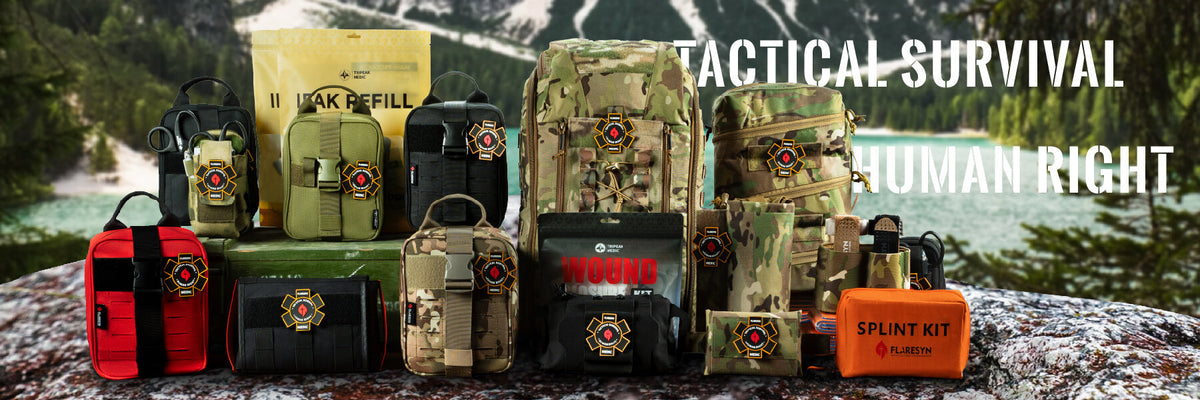
IFAK Checklist 2025: What to Pack, How to Carry It, and How to Keep It Ready (FlareSyn Field Guide)
|
|
Temps de lecture 5 min
|
|
Temps de lecture 5 min
An IFAK (Individual First Aid Kit) is a compact trauma kit designed to control massive bleeding, maintain airway, treat chest wounds, support circulation, and prevent hypothermia—prioritized with the MARCH sequence. A practical 2025 kit should include: a quality tourniquet, compressed/hemostatic gauze, an elastic/pressure bandage, vented chest seals (pair), an NPA with lube, nitrile gloves, trauma shears, and a thermal blanket. Pack for immediate access, check expiry/adhesives regularly, and train on the gear you carry.
What is an IFAK—and why you should carry one:
IFAK = Individual First Aid Kit. It’s a personal trauma kit built for the first minutes after a serious injury, when controlling hemorrhage and managing airway/respiration makes the difference. For responders, range users, outdoor professionals, and anyone building practical preparedness, an IFAK is the “can use right now” kit—small enough to carry, robust enough to stop major bleeding and manage chest injuries until handoff to EMS.
Training disclaimer: This guide supports equipment selection and organization. It does not replace medical training. Whenever possible, take a Stop the Bleed/TCCC/TECC-aligned course and follow local laws and protocols.
Table of Content



NPA (nasopharyngeal airway), typically 28F, with lubricant. Use requires training and appropriate patient selection.
Vented chest seals (pair) to manage open chest wounds (inlet/outlet). Vented designs are broadly useful across real-world scenarios.



mini light/chemlight, face shield, saline wipes, and a sharpie.
EDC / Personal carry (minimal, fast)
1× tourniquet (externally mounted for one-grab access), 1× compressed/hemostatic gauze, 1× pressure/elastic bandage, 1× nitrile gloves, small tape card, mini light. Focus on immediate bleed control and seconds-to-use access.
Vehicle / Fixed post (capacity + refill)
2× tourniquets + spare gauze and bandaging, 2× vented chest seals, 1× NPA + lube, 1–2× thermal blankets, trauma shears, tape/marker. Mount the kit in a visible, reachable location; consider heat exposure on adhesives (summer vehicles).
Range / Training day (multi-casualty awareness)
Multiple “bleed bundles” (TQ + gauze + pressure bandage), 2–4× vented chest seal pairs, 2× NPAs. Clear labeling for training vs. live components (avoid mixing practice items into your real kit).
Duty / Deployment (standardized and compatible)
MOLLE + hook/loop compatible pouching for plate carriers/belts, red pull tabs, tear-away design, logical front-to-back layout. Align with unit SOP for consistent placement and muscle memory.
Tourniquet, compressed/hemostatic gauze, pressure/elastic bandage, vented chest seals (pair), thermal blanket, nitrile gloves, basic tools. Ideal for EDC, glovebox, or first build.
Everything in Standard plus extra gauze, additional bandaging, NPA + lube, and more support items. Better for range officers, instructors, duty users, or anyone supporting more than one casualty.
If your primary use is self-aid and space matters—start Standard. If you may treat others or run events/training, go Pro.
If you want to buy Tactical first aid kits for beginners, you can check out more on our store
A: Tourniquet (1–2), compressed/hemostatic gauze, pressure/elastic bandage, vented chest seals (pair), NPA + lube, gloves, shears, tape/marker, and a thermal blanket.
A: Vented chest seals offer broad compatibility for open chest injuries and are a strong default choice for most users.
A: It’s highly useful, but you must be trained and follow local protocols. Size 28F is common; training will cover assessment and technique.
A: Choose Standard for compact self-aid. Choose Pro for multi-casualty support, classes, or duty use.
A: Check monthly if stored in heat (vehicle). Replace at expiration or if packaging is compromised, especially chest seals and lubricants.


